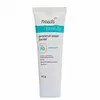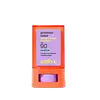What's inside
What's inside
 Key Ingredients
Key Ingredients

 Benefits
Benefits

 Concerns
Concerns

 Ingredients Side-by-side
Ingredients Side-by-side

Water
Skin ConditioningDisodium EDTA
Xanthan Gum
EmulsifyingGlycerin
HumectantAllantoin
Skin ConditioningNiacinamide
SmoothingPotassium Cetyl Phosphate
EmulsifyingAcrylates Copolymer
Octocrylene
UV AbsorberButyl Methoxydibenzoylmethane
UV AbsorberEthylhexyl Salicylate
UV AbsorberEthylhexyl Triazone
UV AbsorberHomosalate
Skin ConditioningButyloctyl Salicylate
Skin ConditioningC12-15 Alkyl Benzoate
AntimicrobialTocopheryl Acetate
AntioxidantPhenoxyethanol
PreservativeCaprylyl Glycol
EmollientBHT
AntioxidantTriacontanyl Pvp
HumectantGlyceryl Stearate
EmollientTriethanolamine
BufferingMethylene Bis-Benzotriazolyl Tetramethylbutylphenol
UV FilterDecyl Glucoside
CleansingPropylene Glycol
HumectantParfum
MaskingSilica
AbrasiveCitric Acid
BufferingWater, Disodium EDTA, Xanthan Gum, Glycerin, Allantoin, Niacinamide, Potassium Cetyl Phosphate, Acrylates Copolymer, Octocrylene, Butyl Methoxydibenzoylmethane, Ethylhexyl Salicylate, Ethylhexyl Triazone, Homosalate, Butyloctyl Salicylate, C12-15 Alkyl Benzoate, Tocopheryl Acetate, Phenoxyethanol, Caprylyl Glycol, BHT, Triacontanyl Pvp, Glyceryl Stearate, Triethanolamine, Methylene Bis-Benzotriazolyl Tetramethylbutylphenol, Decyl Glucoside, Propylene Glycol, Parfum, Silica, Citric Acid
C13-15 Alkane
SolventOryza Sativa Bran Wax
Skin ConditioningHelianthus Annuus Seed Wax
Skin ConditioningOctocrylene
UV AbsorberCoco-Caprylate/Caprate
EmollientC12-15 Alkyl Benzoate
AntimicrobialDibutyl Adipate
EmollientZea Mays Starch
AbsorbentButyl Methoxydibenzoylmethane
UV AbsorberIsododecane
EmollientDicaprylyl Carbonate
EmollientSilica
AbrasiveDiethylamino Hydroxybenzoyl Hexyl Benzoate
UV FilterEthylhexyl Triazone
UV AbsorberC10-18 Triglycerides
EmollientPentaerythrityl Tetrabehenate
EmollientDisteardimonium Hectorite
StabilisingPropylene Carbonate
SolventTriethoxycaprylylsilane
CI 77891
Cosmetic ColorantCI 77492
Cosmetic ColorantCI 77491
Cosmetic ColorantCI 77499
Cosmetic ColorantCI 77007
Cosmetic ColorantCurcuma Longa Root
Skin ConditioningCamellia Sinensis Leaf
PerfumingChamomilla Recutita Flower
Skin ConditioningRosmarinus Officinalis Leaf
Skin ConditioningEthyl Olivate
EmollientEthyl Laurate
EmollientEthyl Linoleate
EmollientJojoba Esters
EmollientXanthophylls
Skin ConditioningQuercetin
AntioxidantCarnosine
Skin ConditioningPentaerythrityl Tetra-Di-T-Butyl Hydroxyhydrocinnamate
AntioxidantWater
Skin ConditioningNiacinamide
SmoothingTranexamic Acid
AstringentPEG-40 Hydrogenated Castor Oil
EmulsifyingTrideceth-9
EmulsifyingPhenoxyethanol
PreservativeC13-15 Alkane, Oryza Sativa Bran Wax, Helianthus Annuus Seed Wax, Octocrylene, Coco-Caprylate/Caprate, C12-15 Alkyl Benzoate, Dibutyl Adipate, Zea Mays Starch, Butyl Methoxydibenzoylmethane, Isododecane, Dicaprylyl Carbonate, Silica, Diethylamino Hydroxybenzoyl Hexyl Benzoate, Ethylhexyl Triazone, C10-18 Triglycerides, Pentaerythrityl Tetrabehenate, Disteardimonium Hectorite, Propylene Carbonate, Triethoxycaprylylsilane, CI 77891, CI 77492, CI 77491, CI 77499, CI 77007, Curcuma Longa Root, Camellia Sinensis Leaf, Chamomilla Recutita Flower, Rosmarinus Officinalis Leaf, Ethyl Olivate, Ethyl Laurate, Ethyl Linoleate, Jojoba Esters, Xanthophylls, Quercetin, Carnosine, Pentaerythrityl Tetra-Di-T-Butyl Hydroxyhydrocinnamate, Water, Niacinamide, Tranexamic Acid, PEG-40 Hydrogenated Castor Oil, Trideceth-9, Phenoxyethanol
Ingredients Explained
These ingredients are found in both products.
Ingredients higher up in an ingredient list are typically present in a larger amount.
Also known as Avobenzone, this ingredient is a chemical sunscreen filter that provides protection in the UV-A range.
Avobenzone is globally approved and is the most commonly used UV-A filter in the world.
Studies have found that avobenzone becomes ineffective when exposed to UV light (it is not photostable; meaning that it breaks down in sunlight). Because of this, formulations that include avobenzone will usually contain stabilizers such as octocrylene.
However, some modern formulations (looking at you, EU!) are able to stabilize avobenzone by coating the molecules.
Avobenzone does not protect against the UV-B range, so it's important to check that the sunscreen you're using contains other UV filters that do!
The highest concentration of avobenzone permitted is 3% in the US, and 5% in the EU.
Learn more about Butyl MethoxydibenzoylmethaneC12-15 Alkyl Benzoate is made up of Benzoic Acid and long chain alcohols. It has a low molecular weight.
C12-15 Alkyl Benzoate is an emollient and texture enhancer. Due to its solubility, it is often used in sunscreens to help evenly distribute active ingredients.
As an emollient, C12-15 Alkyl Benzoate helps soften and hydrate your skin. Emollients create a film on your skin that traps moisture within.
This ingredient has been reported to cause eye irritation.
Learn more about C12-15 Alkyl BenzoateEthylhexyl Triazone is a modern chemical sunscreen that protects from UV-B radiation.
It is the most effective of existing UV-B filters, as it provides the highest level of photo-stable absorption. It protects from the entire UV-B range (280 to 320nm), with it's highest level of protection at 314nm.
Ethylhexyl Triazone is oil soluble, oderless and colorless, which mean it is able to be incorporated into a variety of different formulations.
It is not currently available within the United States due to slow changing FDA regulations. Outside of the US, it is used in formulations at concentrations up to 5%.
Learn more about Ethylhexyl TriazoneNiacinamide is a multitasking form of vitamin B3 that strengthens the skin barrier, reduces pores and dark spots, regulates oil, and improves signs of aging.
And the best part? It's gentle and well-tolerated by most skin types, including sensitive and reactive skin.
You might have heard of "niacin flush", or the reddening of skin that causes itchiness. Niacinamide has not been found to cause this.
In very rare cases, some individuals may not be able to tolerate niacinamide at all or experience an allergic reaction to it.
If you are experiencing flaking, irritation, and dryness with this ingredient, be sure to double check all your products as this ingredient can be found in all categories of skincare.
When incorporating niacinamide into your routine, look out for concentration amounts. Typically, 5% niacinamide provides benefits such as fading dark spots. However, if you have sensitive skin, it is better to begin with a smaller concentration.
When you apply niacinamide to your skin, your body converts it into nicotinamide adenine dinucleotide (NAD). NAD is an essential coenzyme that is already found in your cells as "fuel" and powers countless biological processes.
In your skin, NAD helps repair cell damage, produce new healthy cells, support collagen production, strengthen the skin barrier, and fight environmental stressors (like UV and pollution).
Our natural NAD levels start to decline with age, leading to slower skin repair, visible aging, and a weaker skin barrier. By providing your skin niacinamide, you're recharging your skin's NAD levels. This leads to stronger, healthier, and younger looking skin.
Another name for vitamin B3 is nicotinamide. This vitamin is water-soluble and our bodies don't store it. We obtain Vitamin B3 from either food or skincare. Meat, fish, wheat, yeast, and leafy greens contain vitamin B3.
The type of niacinamide used in skincare is synthetically created.
Learn more about NiacinamideOctocrylene protects skin from sun damage. It absorbs UV-B with peak absorption of 304 nm. It is a common sunscreen ingredient and often paired with avobenzone, a UVA filter. This is because octocrylene stabilizes other sunscreen ingredients by protecting them from degradation when exposed to sunlight. Octocrylene is a photostable ingredient and loses about 10% of SPF in 95 minutes.
Octocrylene also acts as an emollient, meaning it helps skin retain moisture and softens skin. It is oil-soluble and hydrophobic, enhancing water-resistant properties in a product.
Those who are using ketoprofen, a topical anti-inflammatory drug, may experience an allergic reaction when using octocrylene. It is best to speak with a healthcare professional about using sunscreens with octocrylene.
The EU allows a maximum of these concentrations:
Learn more about OctocrylenePhenoxyethanol is a preservative that has germicide, antimicrobial, and aromatic properties. Studies show that phenoxyethanol can prevent microbial growth. By itself, it has a scent that is similar to that of a rose.
It's often used in formulations along with Caprylyl Glycol to preserve the shelf life of products.
Silica, also known as silicon dioxide, is a naturally occurring mineral. It is used as a fine, spherical, and porous powder in cosmetics.
Though it has exfoliant properties, the function of silica varies depending on the product.
The unique structure of silica enhances the spreadability and adds smoothness, making it a great texture enhancer.
It is also used as an active carrier, emulsifier, and mattifier due to its ability to absorb excess oil.
In some products, tiny microneedles called spicules are made from silica or hydrolyzed sponge. When you rub them in, they lightly polish away dead skin layers and enhance the penetration of active ingredients.
Learn more about SilicaWater. It's the most common cosmetic ingredient of all. You'll usually see it at the top of ingredient lists, meaning that it makes up the largest part of the product.
So why is it so popular? Water most often acts as a solvent - this means that it helps dissolve other ingredients into the formulation.
You'll also recognize water as that liquid we all need to stay alive. If you see this, drink a glass of water. Stay hydrated!
Learn more about Water